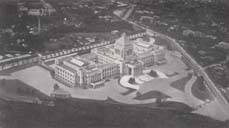Tokyo
From Kaiserreich
|
Tokyo (東京, Tōkyō?) is the Capital of Japan
History
Tokyo's rise to importance can be largely attributed to two men: Tokugawa Ieyasu and Emperor Meiji. Tokugawa Ieyasu made Edo (the forerunner of Tokyo) his base. When he became shogun in 1603, the town began to grow into the capital of his nationwide military government. It became one of the largest cities in the world with a population topping one million by the 18th century. It became the de facto capital of Japan even while the emperor lived in Kyoto, the imperial capital.
After about 263 years, the shogunate was overthrown under the banner of restoring imperial rule. In 1869, the 17-year-old Emperor Meiji moved to Edo, which was renamed "Tokyo" ("Eastern Capital") the year before. Tokyo was already the nation's political and cultural center, and the emperor's residence made it a de facto imperial capital as well with the former Edo Castle becoming the Imperial Palace. The National Diet Building is almost completed and will be inaugurated at the beginning of 1936.
Central Tokyo, like Osaka, has been designed since about the turn of the century (1900) to be centered around major train stations in a high-density fashion, so suburban railways were built relatively cheaply at street level and with their own right-of-way. This differs from other world cities, such as Los Angeles, that are low-density and automobile-centric. Though expressways have been built, the basic design has not changed to this day.
Tokyo was hit by powerful earthquakes in 1703, 1782, 1812, 1855 and 1923. The 1923 earthquake, with an estimated magnitude of 8.3, killed 142,000 people.

